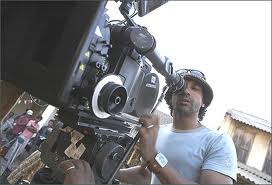The Indian film industry is one of the largest in the world producing as high as thousands of movies in different languages every year. The Hindi movie market has now spread almost all over the world with many such movies even having world premier now opening on the same day at different cities on the globe.
But as Hindi movies are reaching out to the world, world movies are also coming down to India. Suddenly movie-makers in Hollywood have found India an exotic place to shoot.
Nobody who watched Mission Impossible over a decade ago would have imagined that scenes from one of its sequels would be shot in India. Not so long back, action hero Jackie Chan was in the country to promote The Myth, a portion of which was shot in Hampi, in South India.
A major part of the Angelina Jolie-starring role in A Mighty Heart was shot in Pune and Mumbai in western India. Julia Roberts was in Pataudi to film for Eat Pray Love.
Even the much-anticipated Batman movie, The Dark Knight Rises, has a sequence set at the Mehrangarh Fort in Jodhpur in the deserts of Rajasthan. The crew of Mission Impossible 4: Ghost Protocol chose the bylanes of Mumbai to film a high-octane car chase, while director Ang Lee has shot for Life of Pi in Puducherry in south India.
In addition to tapping into India’s large English-speaking market, Hollywood directors are also giving Western audiences a slice of India, much the way Hollywood has shaped the urban Indian perceptions about the US.
The economics of shooting a film in India also works well for Western film-makers who find India a much cheaper place to shoot a film than, say, Europe or the US.
Unlike shooting in other countries, which may be unfamiliar with cinema and have little technical manpower available to shoot a film, India’s thriving film industry also provides the Western filmmakers easy access to production units, equipment and manpower.
With more and more film cities coming up in different places in India, one can now very easily walk in with an idea and walk out with a film from there. There are at least four large film industries in South India, not to mention indigenous industries in regions like Uttar Pradesh in north India and Bihar in east India. At the same time India has all sorts of natural phenomena like hills, sea, jungle, desert.
The recent crop of made-in-India Hollywood films has much to do with their content, which is increasingly South Asia. And for that most film-makers are opting India as their location.
The scenes from Pakistan in A Mighty Heart, the Hollywood film on slain Wall Street Journal reporter Daniel Pearl, were actually shot in Pune, in western India.
When Kathryn Bigelow, director of the Academy Award winner The Hurt Locker, decided to shoot a film on the killing of al-Qaida leader Osama Bin Laden, it was pretty obvious that she would not be able to enter Osama’s den in Pakistan for her film.
Not surprisingly, she is now in the midst of creating scenes from Abbotabad in Manimajra, Chandigarh in north India.
However, it’s not always easy to shoot in India. Siddharth Sirohi, a production designer for Indian and international films, narrated his experience. He was part of the crew for Canadian filmmaker Deepa Mehta’s Water, a film on the lives of widows in Varanasi in northern India.
“The crew was heckled by goons sent by a local politician who accused the film-makers of showing Indian women in poor light, without ever having read the script,” he says. Another reason for India being a difficult destination for foreign film-makers is that the Indian film industry is structured very differently from the industry abroad.
“In India, for instance, an assistant director reports to the director, and is involved in the creative side of a film, whereas abroad he is the producer’s man,” says Sirohi.
The mob that gathers on the streets at the sight of a camera does not make it any easier to make a film in India. But that, many firangi film-makers will tell you, is part of the passage to India. And from the way they are making a beeline for our locales, they must be having a lot of fun doing that.




